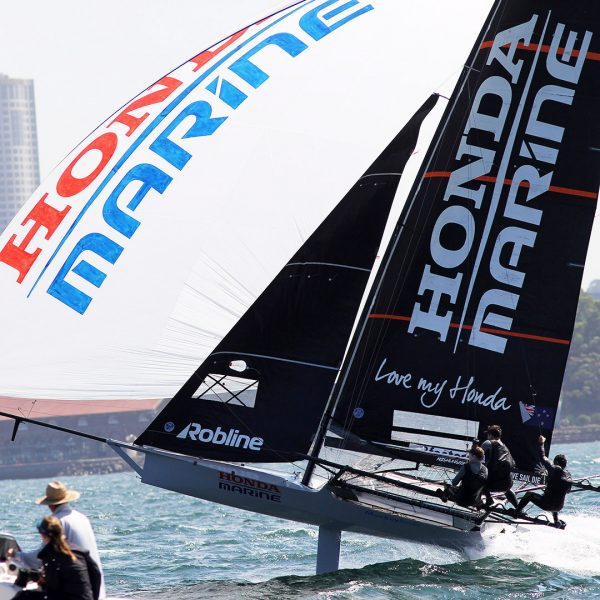It’s not the first time the kiwis have tasted success. It’s just the latest chapter of an 82-year-old story of New Zealand’s 18ft Skiff Racing determination, innovation and championship success.
The story began at the inaugural JJ Giltinan regatta on Sydney Harbour in 1938, when New Zealand sent three boats to race against the might of the Australian 18s, and has continued throughout the championship’s long history.
Australian administrators were so impressed by the challenge that they awarded the 1939 championship to Auckland. While the result was controversial, the regatta was a huge success as spectators along the foreshore were estimated at 25,000 people. When a local boat named Manu, won the title a great tradition of 18ft Skiff Racing was born in New Zealand.
Innovators who were prepared to experiment in their quest for victory have been wonderful contributors to the evolution of the 18s, particularly between the 1950s and 1970s.
It began in 1950 when Jack Logan believed that he wouldn’t beat the Australians in the boat he sailed at the 1948 championship. He decided to browse through some old plans of his late father, who was a master designer and boat builder, and came across a design on a piece of 50-year-old parchment paper that gave him an idea for a new skiff.
Logan drew out the design, chopped off the bow and gave her a transom in place of a pointed stem. The public called her a ‘skimmer’, but Logan reckoned she was more like a frying pan, complete with a handle. He rigged the boat with the latest Bermudan rig, polished her hull to a mirror-finish, and christened her Komutu, the Maori word for surprise.
At the 1950 championship in Auckland, the Australian teams were unable to match the phenomenal speed of this highly unusual boat and were convincingly defeated in the three-race regatta.
Legendary Australian sailor Bill Barnett won the 1951 title back for Australia with Myra Too on Sydney Harbour, but New Zealand immediately struck back the following year when the championship was sailed out of the Royal Suva Yacht Club in Fiji.
Peter Mander progressed the design and innovation in the 18s at the 1952 championship with his championship-winning Intrigue, which was a cold-moulded round-bilge hull. It had a much more buoyant hull shape than the Australian 18s and weighed around 250 lbs, compared to the 400 lbs Australian 18s.
Intrigue also introduced the idea of having two of her five-man crew on trapeze wires which was claimed at the time “enabled one man to virtually have the leverage of two.”
By the 1954 Championship all New Zealand boats had trapeze men, (they carried three men on the wire, sometimes four), swivelling masts and fittings. The hulls were built of cold moulded two and three skins diagonally laid planking.
New Zealand’s designers and sailors had become great innovators and it wasn’t a surprise that their innovations immediately changed the style of 18 Footers in Australia.
The next two championships during the 1950s went to Australian teams before the New Zealanders could get their names back on the Giltinan Trophy in 1960, when Bernie Skinner’s Surprise defeated a small fleet in Auckland, and gave the kiwis their lone victory for the kiwis in the 1960s.
Despite the lack of success in the 60s, there were signs of a revival early in the 70s when Bruce Farr-designed boats began to compete strongly against the top Australian teams. In 1971, only the consistency of the experienced TraveLodge team prevented a victory for Miss UEB.
When the 1972 championship was contested on Brisbane’s Waterloo Bay, the next era of New Zealand success in the 18s became a reality when Don Lidgard’s Smirnoff totally dominated the fleet.
Once again, this quickly led to a general move by most of the leading Australian teams to this new design, and in 1973 Bob Holmes won his fifth title when he skippered TraveLodge to victory on Sydney Harbour.
The following year was another victory for the TraveLodge hotel group, but this time it was an outstanding victory for Terry McDell’s TraveLodge New Zealand team with a dominant performance on Waitemata Harbour, Auckland.
Unfortunately for New Zealand 18ft Skiff Racing, McDell’s 1974 victory was the last for the kiwis until David McDiarmid won the first of his three consecutive victories with Honda Marine in 2018. The Honda Marine team has since proved itself to be an outstanding champion outfit against the best of the Australian 18s teams

